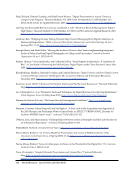SPEC Kit 329: Managing Born-Digital Special Collections and Archival Materials · 125
Yale University
Born Digital Archival Acquisition. Collection &Accession Guidelines
DRAFT – July 2011
nancy.kuhl@yale.edu
BEINECKE RARE BOOK &MANUSCRIPT LIBRARY
BORN DIGITAL ARCHIVAL ACQUISITION
COLLECTION &ACCESSION GUIDELINES
The Beinecke Library (BRBL) is committed to collecting, preserving, and providing access to
important literary archives including materials documenting creative processes, writing lives,
aesthetic communities, publication records, etc. in a range of formats and media. In keeping with
this commitment, the Library recognizes and appreciates the increasing and inevitable
significance of born-digital materials in literary archives. We have established, therefore, a
flexible framework for working with archive creators and their representatives in various
contexts to systematically, efficiently, and safely work with born digital manuscripts,
correspondence, and related materials as they are acquired, accessioned, organized, maintained,
accessed, and used for various research and education purposes.
To that end, the Beinecke Library employs the following guidelines in approaching the
assessment, evaluation, collection, capture, accession, and preservation of materials created
using digital media
--BRBL collects digital archival materials in any and all relevant formats (including text, image,
sound, etc)
--In acquiring born digital materials, a forensic approach, including the capture by “snapshot” of
all working files on a specific computer, will be the preferred method of acquisition in most
cases BRBL will wish to capture entire digital environments without any advanced collection
editing by creator or curator
--Because BRBL is interested in collecting digital materials that have substantive research value,
such materials may be segregated from other materials in a broadly-conceived digital archive
(spam and other commercial email, for example, may be excluded extensive personal image or
sound file collections may be curated by BRBL before collection and accession). This more
limited acquisitions approach will be applied primarily in cases where a small group of materials
are to be acquired (a specific body of correspondence, for instance) and not in the case of
acquisition of a complete archive
--In order to retain whatever organization, file structures, and associated data exists in the a
digital archive or collection, BRBL staff members need direct access to digital files in their
original environment to perform data appraisal, capture, and verification it is suggested that
representatives of archive creators (family and friends, book dealers, agents) should not
manipulate, rearrange, extract, copy etc. data from its original source in anticipation of offering
the materials to BRBL for gift or purchase.
Yale University
Born Digital Archival Acquisition. Collection &Accession Guidelines
DRAFT – July 2011
nancy.kuhl@yale.edu
BEINECKE RARE BOOK &MANUSCRIPT LIBRARY
BORN DIGITAL ARCHIVAL ACQUISITION
COLLECTION &ACCESSION GUIDELINES
The Beinecke Library (BRBL) is committed to collecting, preserving, and providing access to
important literary archives including materials documenting creative processes, writing lives,
aesthetic communities, publication records, etc. in a range of formats and media. In keeping with
this commitment, the Library recognizes and appreciates the increasing and inevitable
significance of born-digital materials in literary archives. We have established, therefore, a
flexible framework for working with archive creators and their representatives in various
contexts to systematically, efficiently, and safely work with born digital manuscripts,
correspondence, and related materials as they are acquired, accessioned, organized, maintained,
accessed, and used for various research and education purposes.
To that end, the Beinecke Library employs the following guidelines in approaching the
assessment, evaluation, collection, capture, accession, and preservation of materials created
using digital media
--BRBL collects digital archival materials in any and all relevant formats (including text, image,
sound, etc)
--In acquiring born digital materials, a forensic approach, including the capture by “snapshot” of
all working files on a specific computer, will be the preferred method of acquisition in most
cases BRBL will wish to capture entire digital environments without any advanced collection
editing by creator or curator
--Because BRBL is interested in collecting digital materials that have substantive research value,
such materials may be segregated from other materials in a broadly-conceived digital archive
(spam and other commercial email, for example, may be excluded extensive personal image or
sound file collections may be curated by BRBL before collection and accession). This more
limited acquisitions approach will be applied primarily in cases where a small group of materials
are to be acquired (a specific body of correspondence, for instance) and not in the case of
acquisition of a complete archive
--In order to retain whatever organization, file structures, and associated data exists in the a
digital archive or collection, BRBL staff members need direct access to digital files in their
original environment to perform data appraisal, capture, and verification it is suggested that
representatives of archive creators (family and friends, book dealers, agents) should not
manipulate, rearrange, extract, copy etc. data from its original source in anticipation of offering
the materials to BRBL for gift or purchase.










































































































































































































